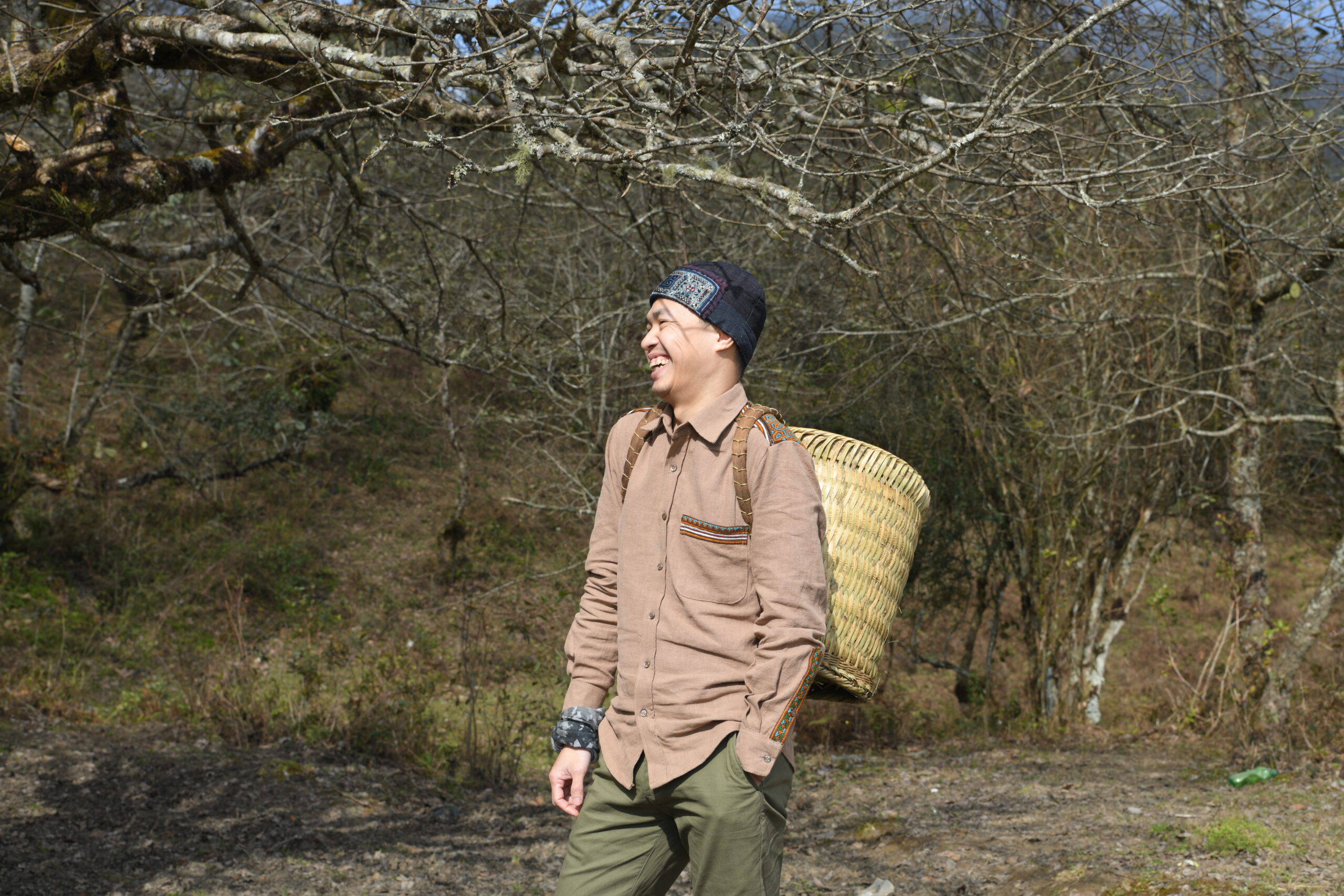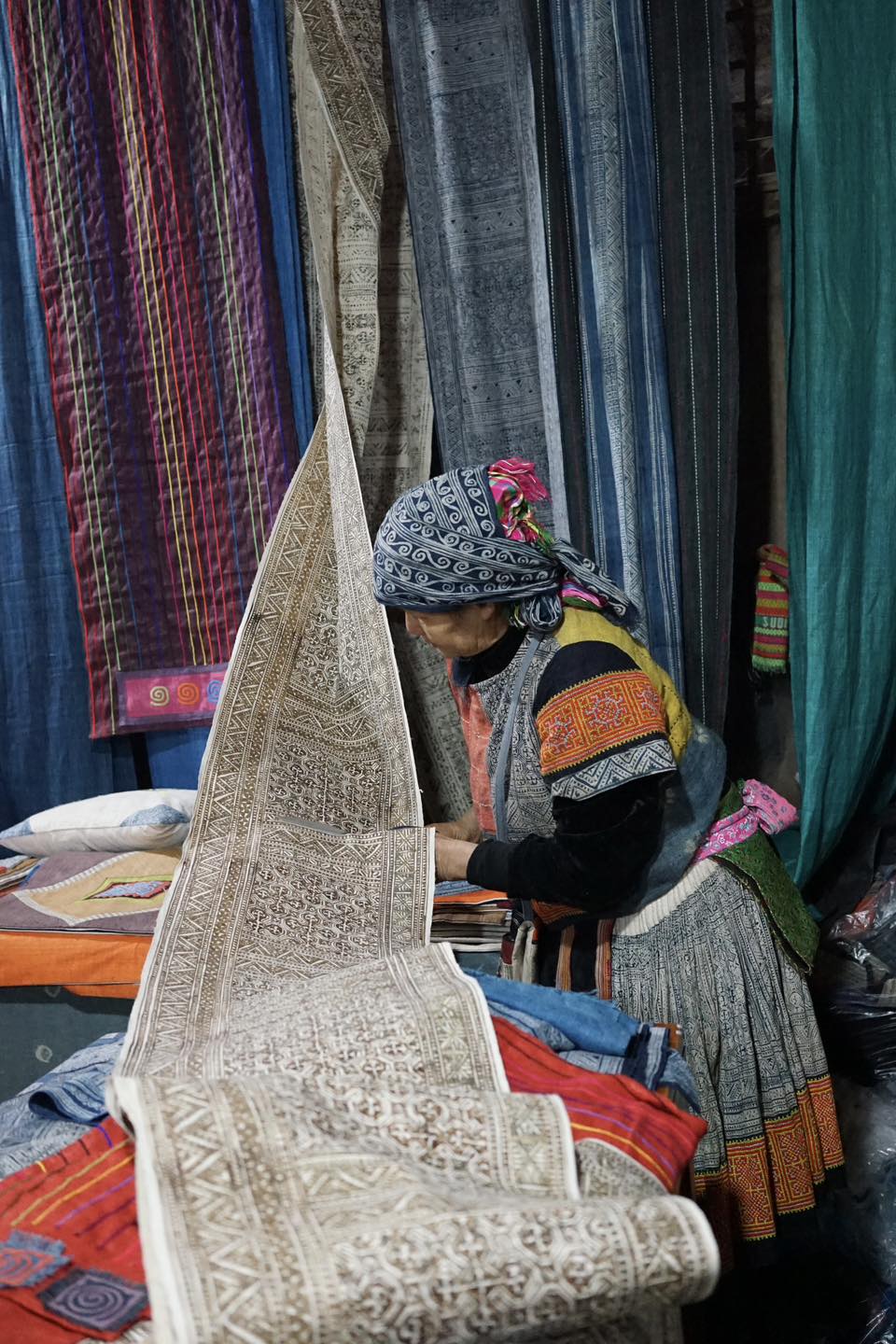From the graceful flared skirts of the Thai women, the indigo-embroidered hues of the Dao, to the dazzling brocades of the H’Mong, every stitch and every shade carries history, philosophy, and deep spiritual meaning—creating a vibrant, one-of-a-kind tapestry on the cultural map of Northwest Vietnam.
The Radiant Fragments of the Highlands
The attire of the H’Mong people stands out with its abundance of decorative techniques and bold colors, reflecting vitality and remarkable adaptability to the rugged mountain environment. A signature feature is the traditional batik wax-resist dyeing technique, a meticulous art form in which hot beeswax is used to draw patterns on linen or cotton fabric before indigo dyeing. When the wax is removed, the white motifs emerge vividly against the deep indigo background—creating striking contrast and long-lasting beauty.
H’Mong garments often feature colorful patchwork on the sleeves, back, and pleated skirts. Dominant motifs are geometric and spiral patterns resembling buffalo or goat horns—symbols of fertility, protection, and prosperity. The color palette is deeply symbolic: red and pink represent luck and joy, while green and blue evoke nature, mountains, and life itself.

In contrast, the attire of the Thai (both Black and White Thai groups) embodies simplicity, elegance, and harmony—mirroring the gentle rhythm of valley life and wet-rice civilization. Their signature garment, the Xửa Cóm (tight-fitting blouse), is fastened with a line of butterfly-shaped silver or bronze buttons along the side, accentuating the wearer’s graceful form. Thai women wear long indigo or black skirts, unadorned but refined in weaving technique. Indigo—their dominant color—symbolizes connection to the earth, water, tranquility, and endurance. The highlight is the Piêu scarf, a true work of art adorned with hand-embroidered patterns at both ends. It is not merely an accessory but a symbol of love and fidelity, often given as a token of affection and lifelong promise.
Meanwhile, the attire of the Dao (Red Dao, Dao Tiền) most vividly expresses spirituality, hierarchy, and the sacred connection between humans and the divine. Dominated by deep indigo and striking red (especially among the Red Dao), these colors represent fire, light, and a spiritual faith powerful enough to dispel evil and attract prosperity. Dao garments are densely hand-embroidered with multicolored cotton threads, forming bold, intricate patterns across the chest, sleeves, and back. The motifs often incorporate ancient Chinese-inspired symbols, mythical creatures such as birds, dragons, and tigers, or even map-like depictions of ancestral migrations—reflecting a profound reverence for origins. Large silver ornaments are essential accessories, believed to protect health, attract good fortune, and enhance the wearer’s spiritual presence.
Cultural Spirit in Every Garment at A Bản
At A Bản, we believe that an authentic cultural experience should not stand apart—it should flow naturally through every sense and every interaction. From architecture and cuisine to the people who welcome you, we seek to embody the true spirit of the highlands with clarity and subtlety.

Our question has always been: How can every detail—from space to dish to attire—carry the essence of the Northwest in a way that feels both genuine and refined? Beyond serving cuisine that celebrates local flavors, we also want culture to live through every garment and familiar object in daily service.
In collaboration with cultural designers, we created A Bản’s uniforms guided by two core principles: Authenticity in Essence, Modernity in Function.
Indigo and black were chosen as the main palette—echoing the attire of the Thai and Dao—while minimalist geometric trims inspired by H’Mong patterns accent the collars and cuffs. This design retains the authenticity of traditional colors and motifs while simplifying ornate details for elegance and practicality. The uniforms are lightweight, comfortable, and perfectly suited for restaurant operations—easy to move in, breathable, and effortless to maintain.

This harmony of tradition and utility is our way of proving that cultural values can be seamlessly woven into modern life—beautifully, naturally, and meaningfully.
Above all, each uniform reflects A Bản’s deep respect and admiration for the rich cultures of Vietnam’s highland communities. To us, culture is not something distant—it lives in how we move, work, and preserve identity every single day.












